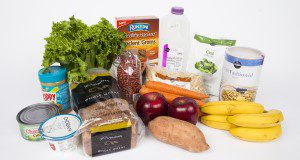If you have diabetes, maintaining a consistent carbohydrate intake throughout the day is an effective meal-planning method to help maintain your target blood glucose levels. Foods that contain carbohydrates have the greatest effect on blood glucose levels compared to foods that contain primarily protein or fat. Carbohydrates in foods that contribute to blood glucose includes sugars and starches. The amount of carbohydrate you consume is based on your diabetes treatment goals and carbohydrate tolerance. This new 3-page publication of the UF/IFAS Food Science and Human Nutrition Department, written by Nancy J. Gal and Wendy J. Dahl, provides a strategy for planning your daily menu to manage your carbohydrate intake.
https://edis.ifas.ufl.edu/fs324
Tag: Carbohydrates
Datos sobre los Carbohidratos
 Los carbohidratos, grasas y proteínas son los tres nutrientes que proveen energía (calorías). Sin embargo, los carbohidratos como los almidones y azúcares son la fuente más importante y principal de energía. Durante la digestión, el almidón se rompe en azúcares (glucosa). Los carbohidratos en forma de glucosa proveen energía a las células, tejidos y órganos para llevar a cabo las actividades diarías. Alguna glucosa se almacena en el hígado y células de los músculos para usarla cuando se requiera. Los niños necesitan carbohidratos para el crecimiento y los adultos necesitan para mantener el peso. This 3-page fact sheet is the Spanish language version of Facts about Carbohydrate, written by Nancy J. Gal, Amanda L. Ford and Wendy J. Dahl, and published by the UF Department of Food Science and Human Nutrition, July 2014.
Los carbohidratos, grasas y proteínas son los tres nutrientes que proveen energía (calorías). Sin embargo, los carbohidratos como los almidones y azúcares son la fuente más importante y principal de energía. Durante la digestión, el almidón se rompe en azúcares (glucosa). Los carbohidratos en forma de glucosa proveen energía a las células, tejidos y órganos para llevar a cabo las actividades diarías. Alguna glucosa se almacena en el hígado y células de los músculos para usarla cuando se requiera. Los niños necesitan carbohidratos para el crecimiento y los adultos necesitan para mantener el peso. This 3-page fact sheet is the Spanish language version of Facts about Carbohydrate, written by Nancy J. Gal, Amanda L. Ford and Wendy J. Dahl, and published by the UF Department of Food Science and Human Nutrition, July 2014.
http://edis.ifas.ufl.edu/fs250
Facts about Carbohydrate
 Carbohydrate, fat, and protein are the three nutrients that provide energy (calories). However, carbohydrate from starch and sugars is our main and most important source of energy. During digestion, starch is broken down to sugar (glucose). Carbohydrate in the form of glucose provides energy to cells, tissues, and organs to carry out daily activities. Some glucose is stored in the liver and muscle cells for later use when required. Children need carbohydrate for growth, and adults need carbohydrate to maintain their weight. This 3-page fact sheet was written by Nancy J. Gal, Amanda L. Ford, and Wendy J. Dahl, and published by the UF Department of Food Science and Human Nutrition, February 2014.
Carbohydrate, fat, and protein are the three nutrients that provide energy (calories). However, carbohydrate from starch and sugars is our main and most important source of energy. During digestion, starch is broken down to sugar (glucose). Carbohydrate in the form of glucose provides energy to cells, tissues, and organs to carry out daily activities. Some glucose is stored in the liver and muscle cells for later use when required. Children need carbohydrate for growth, and adults need carbohydrate to maintain their weight. This 3-page fact sheet was written by Nancy J. Gal, Amanda L. Ford, and Wendy J. Dahl, and published by the UF Department of Food Science and Human Nutrition, February 2014.
http://edis.ifas.ufl.edu/fs243
Carbohydrate Counting: Meals for Diabetes (FSHN1218/FS212)
 “Carb” counting is a way to plan meals to help you maintain target blood glucose levels. Certain foods contain carbohydrate, and these are the foods that most influence your blood glucose. Your body needs carbohydrate in just the right amount. Not enough carbohydrate can lead to low blood glucose (hypoglycemia). Too much carbohydrate can lead to high blood glucose (hyperglycemia). This is why carb counting is a great tool to understand and practice because it can help you control your blood glucose and still give you the freedom to make varied food choices. This 4-page fact sheet was written by Cassie Rowe, Jamila R. Lepore, and Wendy J. Dahl, and published by the UF Department of Food Science and Human Nutrition, March 2013.
“Carb” counting is a way to plan meals to help you maintain target blood glucose levels. Certain foods contain carbohydrate, and these are the foods that most influence your blood glucose. Your body needs carbohydrate in just the right amount. Not enough carbohydrate can lead to low blood glucose (hypoglycemia). Too much carbohydrate can lead to high blood glucose (hyperglycemia). This is why carb counting is a great tool to understand and practice because it can help you control your blood glucose and still give you the freedom to make varied food choices. This 4-page fact sheet was written by Cassie Rowe, Jamila R. Lepore, and Wendy J. Dahl, and published by the UF Department of Food Science and Human Nutrition, March 2013.
http://edis.ifas.ufl.edu/fs212
